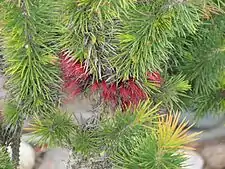Calothamnus pinifolius
Calothamnus pinifolius, commonly known as dense clawflower, is a plant in the myrtle family, Myrtaceae and is endemic to the south-west of Western Australia. It is an erect shrub with dense foliage and clusters of red flowers, partly immersed in the prickly foliage, between July and January.
| Calothamnus pinifolius | |
|---|---|
.JPG.webp) | |
| C. pinifolius at East Mount Barren | |
| Scientific classification | |
| Kingdom: | Plantae |
| Clade: | Tracheophytes |
| Clade: | Angiosperms |
| Clade: | Eudicots |
| Clade: | Rosids |
| Order: | Myrtales |
| Family: | Myrtaceae |
| Genus: | Calothamnus |
| Species: | C. pinifolius |
| Binomial name | |
| Calothamnus pinifolius | |
| Synonyms | |
|
Melaleuca peucophylla Craven & R.D.Edwards | |
Description
Calothamnus pinifolius is an erect shrub that grows to 0.3–2.0 m (1–7 ft) high with a few long shoots and branches and a short shoot emerging from above the leaves of every long one.[2] Its leaves are about 20–30 mm (0.8–1 in) long, crowded, thin and prickly.[3][4]
The flowers are in dense clusters, usually partly hidden by the foliage and have 4 sepals, 4 petals and 4 claw-like bundles of stamens about 25 mm (1 in) long. Flowering occurs between July and January. Flowering is followed by fruits which are woody capsules which have two prominent, curved lobes.[3][4][5]

.JPG.webp)
.JPG.webp)
Taxonomy and naming
Calothamnus pinifolius was first formally described in 1863 by Victorian Government botanist Ferdinand von Mueller in the third volume of Fragmenta Phytographiae Australiae.[1][6] (In 2014 Lyndley Craven, Edwards and Cowley proposed that the species be renamed Melaleuca peucophylla.)[7] The specific epithet (pinifolius) is from the Latin words pinus meaning "pine"[8]:609 and folium meaning "leaf".[8]:466
Distribution and habitat
Calothamnus pinifolius occurs in the Mount Barren Range[3] in the Esperance Plains biogeographic region.[4][5] It grows on slopes in dense scrub in rocky soils derived from laterite and quartzite.[4]
References
- "Calothamnus pinifolius". APNI. Retrieved 6 August 2015.
- Carlquist, Sherwin (1974). Island Biology. New York: Columbia University. p. 294. Retrieved 6 August 2015.
- Hawkeswood, Trevor J. (1984). "Nine new species of Calothamnus Labill. (Myrtaceae: Leptospermoideae) from Western Australia" (PDF). Nuytsia. 5 (1): 124–125. Retrieved 4 August 2015.
- Corrick, Margaret G.; Fuhrer, Bruce A. (2009). Wildflowers of southern Western Australia (3rd ed.). [Kenthurst, N.S.W.]: Rosenberg Publishing. p. 116. ISBN 9781877058844. Retrieved 6 August 2015.
- "Calothamnus pinifolius". FloraBase. Western Australian Government Department of Parks and Wildlife.
- von Mueller, Ferdinand (1863). Fragmenta phytographiae Australiae (Volume 3). Melbourne. pp. 153–154. Retrieved 2 May 2016.
- Craven, Lyn A.; Edwards, Robert D.; Cowley, Kirsten J. (30 June 2014). "New combinations and names in Melaleuca (Myrtaceae)". Taxon. 63 (3): 667. doi:10.12705/633.38.
- Brown, Roland Wilbur (1956). The Composition of Scientific Words. Washington, D.C.: Smithsonian Institution Press.